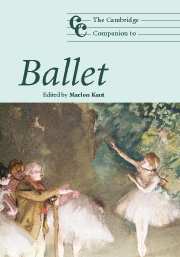Crossref Citations
This Book has been
cited by the following publications. This list is generated based on data provided by Crossref.
Barón-Nusbaum, Brandin
2013.
The Language of Classical Ballet by Flavia Pappacena. 2012. Rome, Italy: Gremese E Editore. 240 pp., 400+ illustrations, bibliographical references. $30.95 paper..
Dance Research Journal,
Vol. 45,
Issue. 2,
p.
151.
2016.
The Cambridge Companion to Film Music.
p.
413.
2017.
The Cambridge Companion to the Musical.
Bourne, Sandie
2018.
Narratives in Black British Dance.
p.
51.
de Oliveira, Solange Ribeiro
2019.
The Cambridge Guide to the Worlds of Shakespeare.
p.
1803.
Isenberg, Nancy
2019.
The Cambridge Guide to the Worlds of Shakespeare.
p.
1819.
Berry, Mark
and
Vazsonyi, Nicholas
2020.
The Cambridge Companion to Wagner's Der Ring des Nibelungen.
Tomić-Vajagić, Tamara
2020.
The Balanchine Dilemma: “So-Called Abstraction” and the Rhetoric of Circumvention in Black-and-White Ballets.
Arts,
Vol. 9,
Issue. 4,
p.
119.
Singh, Yash
Pettit, Matthew
El-Hakeem, Osama
Elwood, Rachel
Norrish, Alan
Audenaert, Emmanuel
and
Khanduja, Vikas
2022.
Understanding hip pathology in ballet dancers.
Knee Surgery, Sports Traumatology, Arthroscopy,
Vol. 30,
Issue. 10,
p.
3546.
Talebi, Mohammad
Campo, Adriaan
Aarts, Noelle
Leman, Marc
and
Jan, Yih-Kuen
2023.
Influence of musical context on sensorimotor synchronization in classical ballet solo dance.
PLOS ONE,
Vol. 18,
Issue. 4,
p.
e0284387.
Cook, Peter J.
2024.
Choreographic Practice in Online Pedagogy.
p.
67.
Oliveira Souza, Maria Thereza
Pedroso, Bruno
Della Giustina Dos Reis, Fabiana
and
Mendes Capraro, André
2024.
Ballet, gender and sexuality: a systematic review in the scopus and web of science databases.
Research in Dance Education,
Vol. 25,
Issue. 4,
p.
425.



